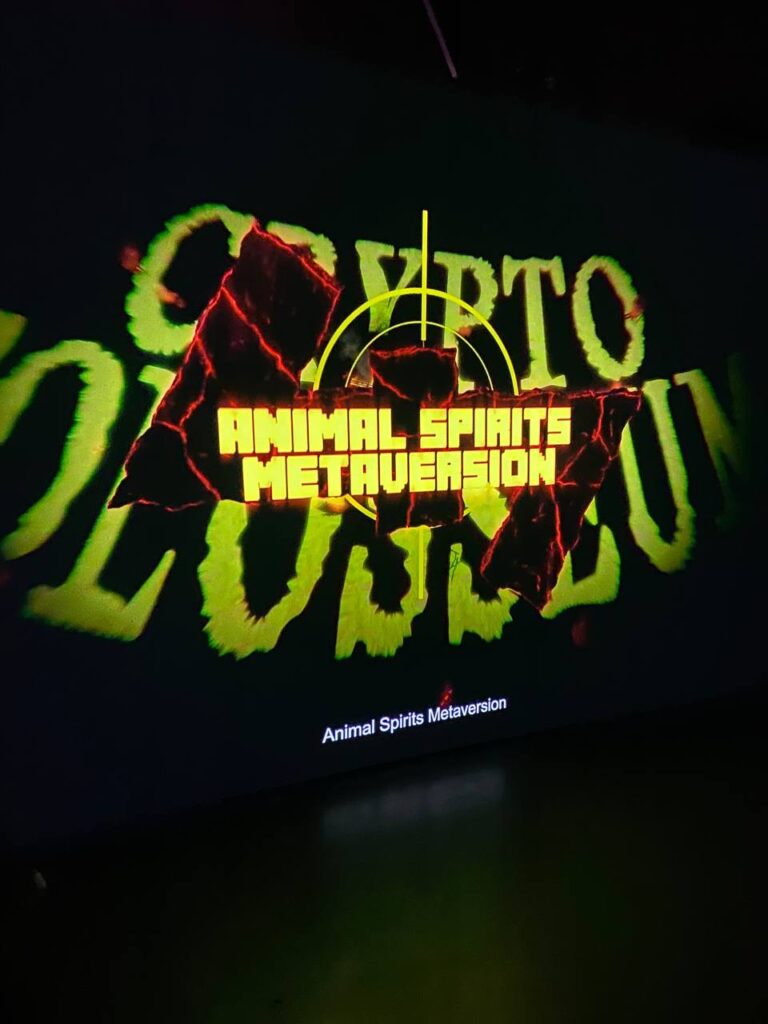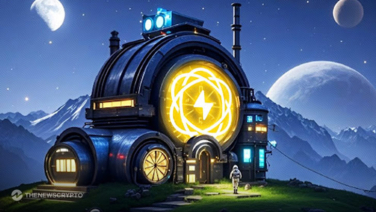- A new exhibition at Esther Schipper Gallery in Berlin unpacks several dominant cultural threads emanating from cryptocurrency and its social, economic and aesthetic comeuppance.
- The works on view are by artist and philosopher Hito Steyerl, whose works explore themes such as globalization, capitalism, and the impact of technology on society, exhibited at major institutions around the world including the Museum of Modern Art (MoMA) in New York, the Venice Biennale, and the Tate Modern in London.
Hito Steyerl’s Animal Spirits at Esther Schipper over Berlin Gallery Weekend is a thought-provoking exploration of cultural production in lieu of several micro-epochs of the last few years. The exhibit takes its name from economist John Maynard Keynes’ concept of human instincts and emotions that influence consumer behavior, and examines it with respect to the rise of NFTs and cryptocurrency.
The centerpiece of the exhibit is a film and AI-animated palaeolithic cave paintings projected on surrounding screens, which create a cave-like environment. The animations respond to the presence of the audience, altering in real-time, creating a unique and immersive experience. The film 24-minute film explores the interplay between wild corporate aesthetics and sheep herders in Spain, which Steyerl filmed on location. A curious combination of themes to be sure, but the sum of which are greater than its individual parts.
Inside the exhibition are living plants encased in glass spheres, hung from the ceiling, illuminated by colored LEDs, these plants contain sensors that measure key parameters for plant health, reacting to the audience and altering the animations in real-time.
As a philosopher and teacher at UdK in Berlin, Steyerl has written considerably on topics like machine learning, AI, technology and economics. In her book Duty-Free Art, in an essay entitled “Is the Internet Dead?” Steyerl asks to what extent we have been led astray by technology as it creates an increasingly bigger presence in our lives.
The essay poses a direct and non-metaphorical question: what has happened to the internet since it became a reality rather than a mere possibility? Steyerl argues that the once-unbounded immateriality of the internet has become entangled with the physical world, which has created a confusing situation. Images, in particular, contain new cultural codes that we are only now beginning to understand.
In the Wretched of the Screen, published in 2012 by Sternberg Press, Steyerl writes:
“The poor image thus constructs anonymous global networks just as it creates a shared history.” She unpacks the speculative nature of image building, as images provoke “translation or mistranslation, and create new publics and debates.”
Steyerl follows this up by suggesting that images create “visual substance” and “political punch” that creates a new aura around them. “This aura is no longer based on the permanence of the ‘original,’ but on the transience of the copy. It is no longer anchored within a classical public sphere mediated and supported by the frame of the nation-state or corporation, but floats on the surface of temporary and dubious data pools.”
Steyerl adds, “A nail polish clip becomes an Instagram riot. An upload becomes a shitstorm. An animated GIF materializes as a pop-up airport transit gate.”
Steyerl’s core philosophical argument is thus quite a compelling one: consider the emoticon as a Matryoshka Basarian paradox, the protest banner as the stylized language of traditional mimicry. Memes as the flags of the 21st century.

In a direct message, the writer and theorist Shumon Basar said of the many contextualities behind Steyerl’s work: “Is it not the case that every ‘contra—’ is duly swallowed up by the the thing the contra— was supposedly against? Thus, Capitalist Realism is less of a neo-Marxist doctrine a la Mark Fisher now, but rather, the basis for a duvet cover design for boys who don’t own bed frames?”
Few images today are more wretched than that of Pepe. The small green anthropomorphic frog with a humanoid body who often appears wryly grinning was appropriated by far-right groups on 4chan, Pepe is today perhaps the most Steyerlian image of the post-modern era. $PEPE is the ultimate symbol of a new prompt reality, emblematic of what Steyerl calls the “circulationism” that “feeds into both capitalist media assembly lines and alternative audiovisual economies.”
Think of Pepe today as the perfect metaphor for the meme economy, with major tokens dictating new crypto-economic flows based on aggregated data and access to economic information, $PEPE has grown from a niche internet meme into a $1 billion market cap cryptocurrency.

Writers and theorists Caroline Busta and Lil Internet have a metaphor for this complex: clearnet versus the dark forest. It’s a metaphor they use to differentiate the space beneath the surface web and a web that is more intricate and opposes the cultural expectations surrounding genuineness and self-promotion that dominate major social media legacy sites like Facebook and Instagram, but whose musings would also aptly apply to an analysis of major trends within cryptocurrency markets and aesthetics.
“Media is no longer linear. Legacy outlets fade into noise, and communities have become screens through which all platforms are diffracted,” Busta and Lil Internet write in a 2023 Outland article.
“Already in the mid-2010s, dark-forest groups had devised ways of finding each other across constellations of platforms (whether by including key emojis in one’s bio—a pine tree, a frog, a black fist, a rainbow flag—or through sharing content from certain meme pages so members of an enclave can synch their clearnet feeds).”
Were not ancient Roman Coins the original memes, or profile pictures that became currency by virtue of the armies and systems they represented?
Uncovering the holographic realities foisted upon us, Steyerl’s documentary films, writings and musings form an oeuvre untethered to any single medium. The sum of which are complexities and multi-layered storytelling narratives that emanate from non-linear systems that mimic the protocol aesthetics that have become such a sad and wretched contemporary condition.
From pump and dump culture to rug pulls, to the ways in which the biological complexities of the earth have been destroyed by extractive technologies, Steyerl’s work reassembles the embryonic prototypes of these conditions into a mass of clear glass spheres illuminated by LED lights.
Ultimately, Steyerl’s work asks us to look beyond the overwhelming swarm of online images to the constant and pervasive surveillance we are subjected to, challenging us to rethink the ways in which social and economic engineering have become such a primal fact of 21-century life, embedded not only in the forms in which we gather and herd sheep but also the ways in which we have come to circulate images and imbue them with meaning.







